#commercial grain mill
Explore tagged Tumblr posts
Text
A year in illustration (2024), Part three


If you'd like an essay-formatted version of this post to read or share, here's a link to it on pluralistic.net, my surveillance-free, ad-free, tracker-free blog:
https://pluralistic.net/2024/12/07/great-kepplers-ghost/art-adjacent

Part one
Part two

Live Nation/Ticketmaster is buying Congress
I had a lot of fun scouring Victorian woodcuts for cool tentacles to add to this image. The garish concert lights in the background were a fun find – I was halfway through using them when I realized that the image came from my old pal Matt Biddulph, who has many claims to fame, but my favorite is that he once sarcastically called the area in Hackney where some tech startups were clustered "Silicon Roundabout" and then experienced the monkey's paw curse of having the government turn this into an official designation.
https://pluralistic.net/2024/04/30/nix-fix-the-tix/#something-must-be-done-there-we-did-something
(Image: Matt Biddulph, CC BY-SA 2.0; Flying Logos, CC BY-SA 4.0; modified)

The specific process by which Google enshittified its search
Around April, I realized I needed a visual signifier for "enshittified Google" – I created a cartoon mascot with the head of a poop emoji, colored in the original Google logo colors. I put him into "The Junior Partner Speaks," an old ad for Pacific Woolens and Worsteds, which I've since used several times:
https://craphound.com/images/juniorpartner.jpg
I'm very fond of using the homely old original Google logo as a way to differentiate pre-enshittificatory Google from modern, enshittocene Google.
https://pluralistic.net/2024/04/24/naming-names/#prabhakar-raghavan
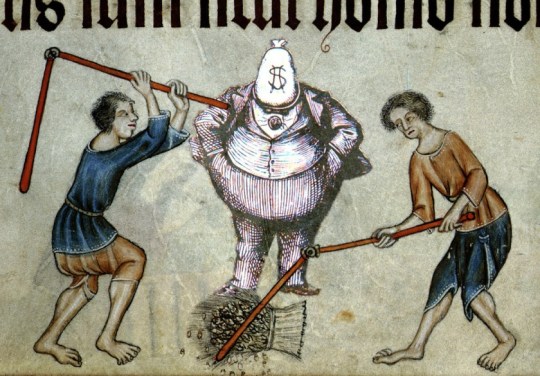
Podcasting "Capitalists Hate Capitalism"
Real Gilded Age corruption-heads will instantly recognize the editorial cartoon image of Boss Tweed as a suited figure with a sack of money for a head; his body language is impeccable, conveying a sneering disregard for decency and others' wellbeing. He works very well inserted into this tapestry of feudal peasants threshing grain.
https://pluralistic.net/2024/04/18/in-extremis-veritas/#the-winnah

No, "convenience" isn't the problem
It's stupidly, unnecessarily hard to find hi-rez scans of Rube Goldberg cartoons online, but this one is perfect and it was a delight to lovingly crop out all its little details. Throw in Cryteria's HAL 9000 and a Matrix code waterfall and you've got a perfect image of the complex, hostile traps of digital systems.
https://pluralistic.net/2024/04/12/give-me-convenience/#or-give-me-death

The unexpected upside of global monopoly capitalism
This one's pretty subtle! I mostly just added the monocle, mustache and top-hat to the fallen head of Goliath in Bosse's 17th century engraving of the triumphant David. The planet Earth in David's sling is a NASA image and thus in the public domain.
https://pluralistic.net/2024/04/10/an-injury-to-one/#is-an-injury-to-all

How to shatter the class solidarity of the ruling class
Goodness, but "canceled" is a tedious cliche. If you must describe someone being ejected from polite society, please consider the far more delightful "defenestrated," not least because the many paintings and etchings of The Defenestration of Prague gives us a lot of public domain visual material to work with when illustrating such events.
https://pluralistic.net/2024/04/08/money-talks/#bullshit-walks
(Image: KMJ, CC BY-SA 3.0, modified)
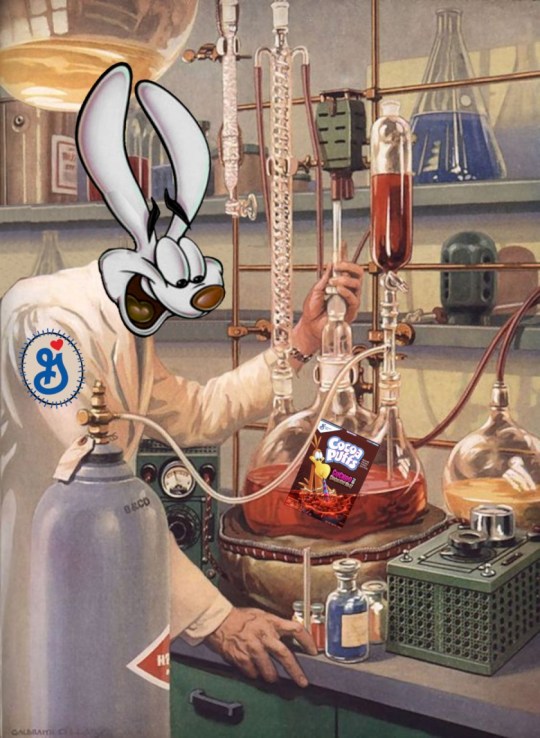
General Mills and cheaply bought "dietitians" co-opted the anti-diet movement
The minute I saw this unsourced midcentury commercial illustration of a scientist working in a chem lab, I knew I'd get a lot of mileage out of it; I spent a long flight productively slicing it onto layers so that I could replace his head and put arbitrary objects in his flask:
https://craphound.com/images/labflask.jpg
I've used him before, but putting the Trix rabbit's head on him and sticking a box of Cocoa Puffs in the flask worked great.
https://pluralistic.net/2024/04/05/corrupt-for-cocoa-puffs/#flood-the-zone-with-shit

Too big to care
I spent the whole flight to SXSW last year slicing up a super hi-rez (10,000px wide!) image of Hieronymus Bosch's "Garden of Earthly Delights," slicing out individual demons, with special attention to the hoof-footed, anus-baring demon in a hat with a whole secret demonic clubhouse in its rectal cavity. At the end of that flight, I had a very funny conversation with my perplexed seatmate, who was dying to know what the actual fuck I was working on.
The background here is made up of desaturated, magnified brushstrokes from Van Gogh's "Starry Night."
https://pluralistic.net/2024/04/04/teach-me-how-to-shruggie/#kagi

Red Lobster was killed by private equity, not Endless Shrimp
I inserted a rogue's gallery of "evil boss types" from various editorial cartoons into this vintage Red Lobster ad, including Boss Tweed, an impatient guy from a midcentury John Falter commercial illustration, possibly for a radio station (?) and a William Gropper sketch for a cartoon making fun of the business lobby's opposition to the New Deal.
https://pluralistic.net/2024/05/23/spineless/#invertebrates

You were promised a jetpack by liars
The newsie with the great grin makes a reappearance in this one, beneath a jetpack flyer taken from a 1928 Amazing Stories cover by R Frank Paul. The control panel is one of several midcentury electronics consoles I've spent idle hours cropping out (this one comes from a Schlitz ad depicting a HAM radio enthusiast). The hypnotic head is from the October, 1953 cover of Doll-Man, likely by Reed Crandall. I started playing around with halftoning with this one, on the background, as a way of hiding the JPEG artifacts that emerged when I uprezzed small source images. It worked really well.
https://pluralistic.net/2024/05/17/fake-it-until-you-dont-make-it/#twenty-one-seconds

AI "art" and uncanniness
I was so happy with how the extra fingers on this Victorian woodcut of a hand on a Oujia board planchette came out. And the green tinting worked perfectly with the Code Waterfall background.
https://pluralistic.net/2024/05/13/spooky-action-at-a-close-up/#invisible-hand
Part four
#art#collages#public domain#creative commons#cc#fair use#copyfight#visual communications#illustration#pluralistic illustrations 2024
34 notes
·
View notes
Text

Archaeologists Uncover 'Prison Bakery' in Pompeii
An ancient bakery operated by slaves has been discovered in the ruins of Pompeii, the Pompeii Archaeological Park said in a statement released Friday.
Enslaved people and donkeys were locked up together and used to power a mill to grind grain for bread, according to details of the discovery provided by the park.
The site consists of a narrow room with no external view but only small, high windows covered by bars through which minimal light passed. There were also indentations in the floor “to coordinate the movement of the animals, forced to walk around for hours, blindfolded,” the statement said.
The discovery was made in the Regio IX section of the popular tourist site, which is also an ongoing archaeological dig. The area is currently being excavated as part of a larger project designed to secure and maintain previously excavated areas of the Roman city.
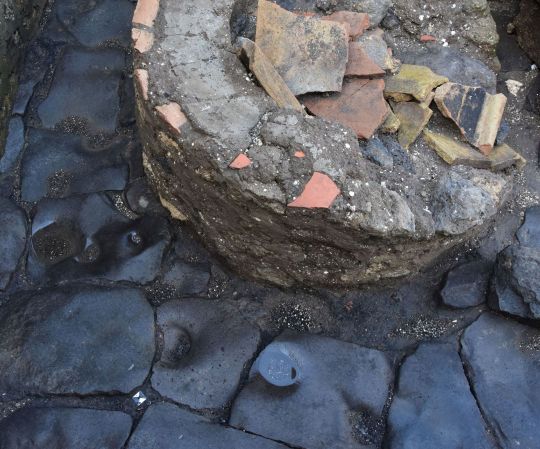
Archaeologists discovered the bakery while excavating an ancient Pompeiian home that was being renovated when Mount Vesuvius erupted in 79 C.E., covering the city of Pompeii with ash.
The bodies of three victims of the eruption were found in recent months, believed to be residents of the home rather than slaves. The house was divided into a residential section with “refined frescoes” on one side, and a commercial bakery on the other.
Next to the bakery was the dimly lit prison area, Pompeii Archaeological Park director Gabriel Zuchtriegel said in an interview posted on the site’s YouTube channel.

“What has emerged is testimony of the backbreaking work to which men, women, and animals were subjected in the ancient mill-bakeries,” he added.
Zuchtriegel said these prison bakeries were previously described by the Roman writer Apuleius in the 2nd century C.E., in his novel “Metamorphoses” (also known as “The Golden Ass”), in which the protagonist, Lucius, “transformed into a donkey and was sold to a miller.” Zuchtriegel said the episode was based on the writer’s direct knowledge of the animals and humans living and working together.

The newly discovered prison area had no doors to the outside, only to the inner atrium.
“It is, in other words, a space in which we must imagine the presence of people of servile status whose owner felt the need to limit the freedom of movement,” Zuchtriegel said.
“It is the most shocking side of ancient slavery, the side devoid of relationships of trust, where it was reduced to brute violence, an impression which is fully confirmed by the closing of the few windows with iron grates.”
Archaeologists also believe that the indentations in the slab flooring were not made by repetitive movement but were carved to prevent the donkeys and other animals from slipping on the pavement and to force them to only walk in a circular motion to grind the grain, almost like a clockwork mechanism.
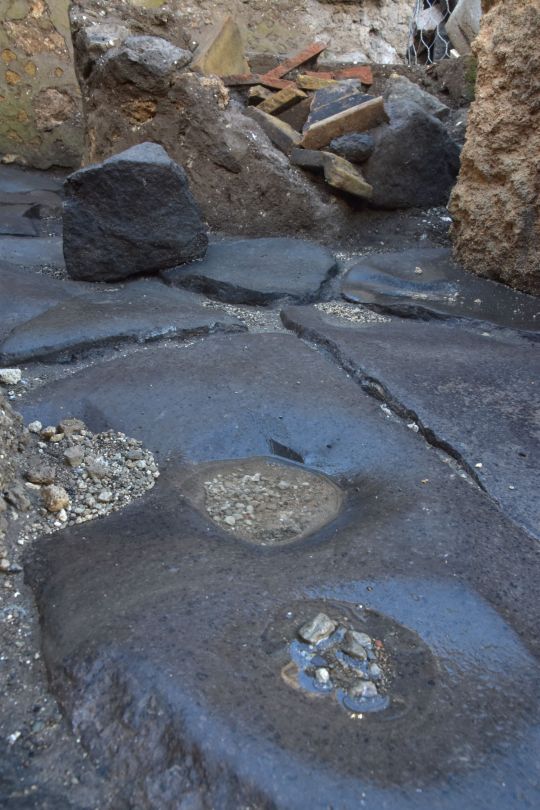
“The iconographic and literary sources, in particular the reliefs from the tomb of Eurysaces in Rome, suggest that a millstone was normally moved by a couple made up of a donkey and a slave,” Zuchtriegel said.
“The latter, in addition to pushing the grindstone, had the task of encouraging the animal and monitoring the grinding process, adding grain and removing flour.”
The site will complement an exhibition that opens December 15, called “The Other Pompeii: common lives in the shadow of Vesuvius,” which is dedicated to what Zuchtriegel calls the “myriad of individuals often forgotten by historical chronicles, such as the slaves, who constituted the majority of the population and whose work contributed significantly to the economy, but also to the culture and social fabric of Roman civilization.”
By Barbie Latza Nadeau.



#pompeii#Archaeologists Uncover 'Prison Bakery' in Pompeii#ancient artifacts#archeology#archeolgst#history#history news#ancient history#ancient culture#ancient civilizations#roman history#roman empire#mount vesuvius
82 notes
·
View notes
Text
My layout is still in the planning stage, but right now this is what I'm thinking:
Small, ~22x80" on one wall with a clamp on tail for a switching lead.
Setting: Vermont or Maine
Era: Between 1995 and the present
Industries: Feed mill and small transload facility
HO Scale
All turnouts #6
Track: Micro Engineering Code 70
Spacing between the main and sidings is 2.5" minimum.

Motive power: 4 axle road switcher
Longest rolling stock: 73' centerbeam flats
Capacity:
Main and siding: Locomotive and 3 cars
Feed Mill siding: 4 cars (only two spotted at a time as they must be pushed through to unload)
Transload siding: 3 cars
Both turnouts will be facing point, cars will be shoved in from the detachable switching lead, switched, and then pulled out.
The feed mill is primarily based off of Phoenix Feeds in New Haven Junction, VT and Depot Farm Supply in Leicester, both on Vermont Railway's Rutland to Burlington trackage. I plan on scratchbuilding the southernmost part of the building and adding commercial grain bins next to it.
The transload facility will take the place of Phoenix Feeds' storage track. I'm planning on basing it off the one in Colfax, WI (44.9967, -91.7281). Off-spots for the feed mill will be stored there. Initially, I'm only planning on transloading lumber there (centerbeams and an occasional box or bulkhead flat), but later I may expand to plastic pellets, steel plate, and occasionally a single hopper of coal. I plan on having a couple mobile ramps for accessing boxcars and potentially mobile unloading racks and a mobile conveyor.
I plan on switching the feed mill twice a week so the primary traffic on the layout will be covered hoppers. Lumber will be delivered every other week or so. Other commodities TBD, but less often than the covered hoppers.
I know I could maximize operational interest by choosing other industries, but I have a soft spot for grain covered hoppers and centerbeams. I also considered replacing the transload facility with a lumberyard, but I think that would make things too crowded.
2 notes
·
View notes
Text
Solarpunk Aesthetic Week Final Day: Worldbuilding Thoughts Three!!!
Because my silly little brain is hyperactive as heck.
"It takes a village to raise a child"? That's true now. The kids in the commune don't need to have dictated caregivers, they just chill with who they want. Houses welcome to children can be marked with a special symbol- Every adult who feels comfortable with kids is in a special groupchat (or the like) for the collective parents to chat about how their kids are all doing. Those adults who don't want to be kid-raisers don't join the group chat and don't mark their house, and kids are taught to not to bother them.
We all pitch in to help with the commune, but also to cover each other on days we can't work for whatever reason! Is it shabbat? Is your mom sick? Are your migraines bad today? Are you feeling burnt out? Do you just not want to? Then you don't have to work to do anything. Of course, a whole lot of manual labor (such as milling wheat and other grains into flour) would be automated with robots! The ickiest worst jobs aren't for anyone.
Lights! Lights on Hanukkah, on Diwali, on Christmas. Window-shutters close automatically on houses past sunset so inhabitants can have their lights on without polluting and confusing animal life. Floating lanterns, a soft glow on a gentle face, kids laughing with fireflies cupped in their hands, a dazzling array of stars blinking quietly down on the Earth..
Allergies, intolerances, and food sensitivities are all respected and taken careful note of, and restaurants offer a diverse array of options including vegan meals and allergy-friendly kosher and halal menus!
Kids are considered kids until their brain is fully developed, but are given agency as soon as they can articulate and move themselves. Kids aren't allowed to leave the commune without supervision, though, but inside the commune it's totally alright cuz eyes on the street.
High-tech hormone readers on cameras with AI trained to detect signs of distress and assault, and begin blaring a loud alarm, could be placed wherever. I'm not one for surveillance states, but if we have fire alarms, we could have alarms for other things too, right?
Communal service dogs! Someone had a seizure, a stroke? BARK BARK BARK BAKRBABRKABABRK
In the cities, perhaps a commune is considered your 15-minute sphere? They're divided and governed as such, but cities can also have higher levels of division if necessary.
Food factories! Greenhouses the size of commercial warehouses, giant aquaponics facilities, all kept by robots and an automatic delivery service to restaurants or homes or wherever need be.
That concludes this set of thoughts, and this Solarpunk Aesthetic Week! Woohoo! I hope everyone had a wonderful time <3
#text post#worldbuilding#solarpunk aesthetic week#solarpunk aesthetic#solarpunk#solarpunk worldbuilding#solarpunk world#city planning#urban design#urban planning#city design#post capitalism#high tech high hope
34 notes
·
View notes
Text

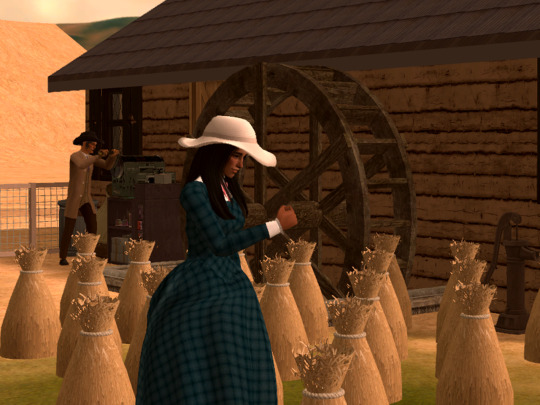

Latika doesn't know what to think about Lloyd's plan. It makes her stomach screw up and she can't help but think about how because of this silly idea, everything is now falling to her! Still, she loves him and knows his heart is in a good place, even if she thinks he isn't using his brain much...
She manages to harvest the grain and mill both a commercial amount and their own stock for the winter.
#ts2#sims 2#the sims 2#ts2 homestead challenge#homestead challenge#neighborhood: alicel#family: hollowbreast#sim: latika hollowbreast#sim: lloyd hollowbreast#y1w4 hollowbreast
3 notes
·
View notes
Text
Why slaves? Roman society had no equivalent of the educated but relatively poor urban classes who supplied Victorian entrepreneurs with their waged clerical assistants. The citizen army produced no retired officers with the kind of generalized administrative experience depended on today in many sectors of business and government. Nor did the freeborn have access to anything like the social and commercial institutions that today allow those with talent and energy to develop career paths to positions of increasing responsibility. Slaves, on the other hand, were malleable. Some were highly educated; indeed most Roman education took place within aristocratic households. Owned for long periods, they could be trained and disciplined to suit their masters’ needs. Most slaves were completely detached from the societies in which they had grown up, or else they were ‘home-bred’. Neither group had any real hope of achieving better conditions except with their owners’ support. Besides, slaves were utterly dependent on their masters. The sanctions for disobedience or dishonesty were horrifying. It was in principle illegal to kill a slave, deliberately at least, although who would bring a case against a master? But slaves might be routinely confined, beaten, even tortured, and there were many lesser sanctions. Cato recommended access to slave women be used as an incentive. Some slaves were allowed to start families, but their partners and children could be sold at a master’s whim. Slaves might hope for softer jobs and their eventual freedom, but they could be reassigned to hard labour if the master preferred. [...]
Cato’s ideal farm would have looked tiny to later generations. Purpose built villas with slave quarters appear in the last century BC, often equipped with luxurious residential quarters. A great mansion excavated at Settefinestre in Tuscany provides a vivid model. An entire urban mansion, secluded garden included, has been transplanted into the countryside and bolted onto a working farm. When the master was present, he would arrive with servile attendants to look after his every need and desire. Meanwhile, a very different category of slaves worked his vineyards, his fields, his mills, and his potteries. Most agricultural slaves were not made to work in chains—hardly practical in most circumstances—but many were branded or wore collars. Even worse were the conditions of the slaves who worked in the mines. And Apuleius, in his novel the Golden Ass, provides a horrific description of a grain mill where slaves ground grain by turning a horizontally mounted wheel in unbearable heat.
O gods above, what poor subhuman creatures were there, their bodies bruised all with livid marks, their backs scarred from beatings, covered rather than clothed, in rags, some just wearing loincloths to preserve their dignity, all of them so practically naked. Some had been branded on the forehead, some had their hair shaved off and some wore shackles. They looked ghastly, and in fact they could hardly see as their eyes were dimmed with muck and smoke in the foul-smelling darkness of that place.
Rome: An Empire's Story by Greg Woolf
To start thinking about Roman slavery is to stare into an infinite abyss of deliberate human suffering. The Roman Empire is considered to be one of the genuine slave states in human history, in that, like the antebellum Southern states of America, it could not exist without slavery. Slavery was the social and economic foundation upon which the entire Roman Empire rested. But while the slave states of Louisiana and Virginia lasted 150 years before abolition, the Roman Empire stood on the backs of unimaginable numbers of enslaved men, women and children for almost a thousand years. A thousand years is thirty-four generations of people enslaved to the Romans. A thousand years before the year I wrote this, King Cnut was glaring down the sea. A thousand years is an immense amount of time. And they didn’t just have domestic slaves, they had vast mines across the Empire for silver, lead, gold, iron and copper. Google the Las Médulas mines in Spain and imagine the sixty thousand enslaved people who worked there twenty-four hours a day to produce the gold the Roman Empire demanded, and then multiply that by hundreds of years and hundreds of sites and all those lives that were sent to toil for nothing and join me staring into this bottomless pit of Roman horror. Then picture the near infinite acres of land owned by the Gaius Caecilius Isidoruses and Melanias of the Roman world, each maintained by chain gangs of hundreds of enslaved people. And on top of that were those enslaved in the house, the cooks and cleaners and washers and dressers, the people enslaved by the state who maintained the aqueducts and laid the roads and built all those temples and fora across the vast Empire and fought fires and carried the emperor in his litter. A general estimate (which means, of course, a total guess but a guess from someone I’d trust in a quantitative situation) is that there were between 4.8 and 8.4 million enslaved people in the Roman Empire at any time, with the city of Rome‘s population including anywhere from ten to twenty-five percent enslaved people. Millions and millions and millions of lives, each a person with a heart full of love and hate and envy and joy and aching knees and sore eyes and dreams and thoughts and desires and hopes, all of whom were owned by another person and subject to the most extraordinary violence every day.
A Fatal Thing Happened on the Way to the Forum: Murder in Ancient Rome by Emma Southon
20K notes
·
View notes
Text
Elevate Your Interiors with Wooden Flooring in Raja Park – Brought to You by SVE Interior
Where Style Meets Functionality
When it comes to designing a home or workspace, flooring often plays the most transformative role. It sets the tone, defines the mood, and creates the foundation for your overall aesthetic. Among the most elegant, warm, and timeless choices in flooring is wood. With its natural textures and stunning finishes, wooden flooring enhances the elegance of any room. If you're seeking a trusted Wooden Flooring Distributor in Raja Park, a reliable Wooden Flooring Dealer in Raja Park, or a well-stocked Wooden Flooring Showroom in Raja Park, look no further than SVE Interior.
SVE Interior is a pioneer in premium interior solutions and has carved a niche in delivering top-quality wooden flooring that perfectly combines aesthetics, durability, and functionality. In this article, we delve into the growing trend of wooden flooring, its benefits, styles, and why SVE Interior is the go-to name for wooden flooring in Raja Park, Jaipur.
Why Wooden Flooring?
Wooden flooring has stood the test of time as a preferred choice across traditional and contemporary interior styles. Its universal appeal lies in its:
Natural Beauty: Warm tones and grains add elegance to any room.
Durability: With proper care, wooden floors can last for decades.
Versatility: Available in a wide variety of styles, finishes, and colors.
Ease of Maintenance: Simple to clean and maintain.
Value Addition: Enhances property value and market appeal.
Whether you’re designing a cozy home, a chic office, or a high-traffic commercial space, SVE Interior offers customized solutions to match every requirement. As a renowned Wooden Flooring Dealer in Raja Park, SVE Interior ensures a premium range of products to choose from.

Types of Wooden Flooring Available at SVE Interior
Understanding the right type of flooring for your space is essential. At SVE Interior, we offer:
1. Engineered Wood Flooring
A top layer of hardwood with layers of plywood underneath. Ideal for areas where moisture levels vary.
2. Hardwood Flooring
With hardwood would you get a natural feeling that can give you comfort according to weather or temperature of your house.
3. Laminate Wood Flooring
A cost-effective alternative, offering wood-like aesthetics and superior scratch resistance.
4. Chevron Flooring
Chevron design is a characteristic flooring pattern. Created using cutting edge equipment, each plank is milled to precision. It is a fashionable flooring.
Each product is displayed with samples at our Wooden Flooring Showroom in Raja Park, where you can see, touch, and choose the perfect option.
SVE Interior – Your Trusted Wooden Flooring Partner
SVE Interior is not just another Wooden Flooring Distributor in Raja Park. We are interior experts with a commitment to quality, creativity, and customer satisfaction. Here’s what sets us apart:
Extensive Product Range: Multiple shades, finishes, and textures
Expert Guidance: In-house designers to help match flooring with your interior theme
Installation Services: Professionally trained team for flawless fitting
Warranty Assurance: Long-term product warranties with after-sales support
Eco-Friendly Products: Sustainably sourced wood options available
As a full-service Wooden Flooring Dealer in Raja Park, SVE Interior handles everything from consultation to installation, making the process seamless for clients.
Customization for Every Space
We understand that each space has its unique personality. That’s why we offer tailor-made wooden flooring solutions for:
Residential Interiors: Bedrooms, living rooms, kitchens
Commercial Spaces: Offices, restaurants, boutiques
Hospitality: Hotels, resorts, lounges
Retail: Showrooms, shopping spaces
Visit our Wooden Flooring Showroom in Raja Park to explore design mockups, test textures underfoot, and get inspired by real-world samples.
The Wooden Flooring Experience at SVE Interior
When you walk into our showroom, you step into an experience. Here’s what you can expect:
Personalized Consultation: One-on-one sessions with flooring experts
Virtual Previews: See how flooring options look in a digital version of your room
Sample Testing: Walk on installed samples to feel the difference
Budget Planning: Transparent cost discussions and flexible pricing packages
We believe flooring should never be an afterthought. It should be the centerpiece of design planning, and as the leading Wooden Flooring Distributor in Raja Park, we ensure every client walks away with confidence and satisfaction.

Installation and Maintenance
Our professional installation services ensure that your flooring is laid perfectly and lasts long. Post-installation, we offer:
Cleaning Tips: Best practices for everyday cleaning
Scratch Prevention: Protective finishes and product recommendations
Repair Assistance: Minor touch-ups and major repair solutions
We equip you with the tools and know-how to keep your floors looking new for years.
Conclusion: The Right Flooring Makes All the Difference
Flooring is more than just a surface—it’s a style statement. When chosen right, it can transform your home or workspace into a welcoming, elegant, and comfortable environment. SVE Interior is proud to be your go-to Wooden Flooring Distributor in Raja Park, offering not just premium products but also complete flooring solutions under one roof.
Explore, experience, and elevate with SVE Interior—the most trusted Wooden Flooring Dealer in Raja Park and the leading Wooden Flooring Showroom in Raja Park.
Let your floors speak your style.
#Wooden Flooring Distributor in Raja Park#Wooden Flooring Dealer in Raja Park#Wooden Flooring Showroom in Raja Park
0 notes
Text
🛠️ Crafted to Perfection: Inside the World of Graber Millworks and Wood Solutions
When it comes to timeless craftsmanship, natural beauty, and enduring quality, nothing compares to finely crafted woodwork. Whether you're remodeling a kitchen, upgrading your floors, or adding custom millwork to elevate your home, Graber Millworks delivers excellence in every detail. From Graber cabinetry to Graber oak flooring, this trusted name in Indiana woodworking has been turning houses into homes with elegance and precision for generations. 🪵🏠

✨ Why Choose Graber Wood Solutions?
At the heart of Graber Wood Solutions lies a deep-rooted passion for craftsmanship. Located in the peaceful town of Odon, Indiana, Graber Millworks offers a full suite of custom woodworking services. From mill works near me to luxurious Graber cabinets Indiana homeowners love, the brand's versatility, reliability, and attention to detail make them a go-to partner for homeowners and builders alike.
Here’s what makes Graber stand out:
✅ Handcrafted quality ✅ Locally sourced hardwoods ✅ Custom designs tailored to your vision ✅ Exceptional durability and finishing ✅ Decades of experience and expertise
🪑 Graber Furniture Odon Indiana: Where Craft Meets Comfort
Looking to enhance your home with timeless, handcrafted furniture? Look no further than Graber Furniture in Odon, Indiana. Each piece is a testament to the art of fine woodworking. From cozy dining sets to elegant bedroom furnishings, Graber creates heirloom-quality pieces that blend aesthetics with everyday functionality. 🛋️
✨ Whether you’re designing a rustic farmhouse or a sleek modern interior, Graber’s custom-built furniture offers the warmth, texture, and strength only solid wood can provide.
🚪 Graber Cabinetry: Custom Storage Meets Classic Design
Cabinetry can transform a space—both in style and function. With Graber cabinetry, homeowners can expect personalized solutions that maximize storage without compromising design. From sleek, modern finishes to rich, traditional wood tones, every Graber cabinet in Indiana is crafted with expert precision and long-lasting quality.
🏡 Perfect for:
Kitchens 🍽️
Bathrooms 🛁
Laundry rooms 🧺
Mudrooms and built-ins 🎯
Graber’s cabinetmakers take the time to understand your needs, ensuring every door, drawer, and shelf serves a purpose while complementing your home’s unique character.
🌳 Graber Oak Flooring: The Foundation of Timeless Beauty
Few elements ground a home like beautiful flooring—and Graber oak flooring is in a class of its own. Known for its rich grain patterns and remarkable durability, oak is a favorite for homeowners seeking both form and function. 🌾
✅ Benefits of Graber’s Oak Flooring:
Scratch and dent resistant 🔨
Available in a variety of stains and finishes 🎨
Environmentally friendly and locally sourced 🌎
Low maintenance and long-lasting durability 🧽
So if you’re Googling “Grabers flooring” or “premium hardwood floors,” you're on the right track. Graber Millworks delivers floors that not only look stunning but are built to withstand daily life.

🔨 Mill Works Near Me: Graber’s Custom Trim & Molding Solutions
If you're searching “mill works near me,” chances are you want local, high-quality custom solutions. Graber Millworks specializes in creating architectural millwork that elevates your home’s design. From intricate baseboards and crown moldings to door frames and wainscoting, their millwork adds depth, character, and a touch of luxury to any space.
🏡 Perfect for:
Home renovations
New builds
Commercial interiors
Historical restorations
Each piece of millwork is milled to perfection, ensuring a seamless fit and flawless finish. ✂️
🏡 Real Homes, Real Results: What Customers Are Saying
Homeowners across Indiana trust Graber Wood Solutions for their remodeling and custom-building needs. From first-time buyers to seasoned contractors, the reviews speak volumes:
💬 “We installed Graber oak flooring last year and it’s held up beautifully with three kids and a dog!” 💬 “Our custom cabinets from Graber gave our kitchen the exact look we were dreaming of!” 💬 “They went above and beyond to make our vision a reality. Highly recommend Graber Millworks.”
💡 Tips for Choosing the Right Graber Wood Product
If you're ready to work with Graber Millworks, here are a few tips to help you make the most informed decision:
📐 Measure your space — Know the dimensions of your room or installation area. 🎨 Choose your style — Rustic, modern, traditional? Graber can customize accordingly. 🌲 Pick your wood — Oak, maple, cherry—each wood type brings a different feel and grain. 🧰 Trust the experts — Graber’s team will help guide your selection and offer professional insight.
Whether it’s Graber cabinetry, Graber oak flooring, or a stunning Greenwood shed, working with experts ensures a finished product you'll love for years. ✨
📍 Why Local Matters: Supporting Indiana Craftsmanship
Choosing Graber Millworks means investing in local artisans, locally sourced materials, and a community-focused business. Whether you're from Indianapolis, Bloomington, or anywhere in between, supporting Graber cabinets Indiana means supporting craftsmanship that uplifts your home—and your community. 🤝

Conclusion
Whether you need custom Graber cabinetry, grabers flooring, or are searching “mill works near me” for your next home project, Graber Millworks is your trusted partner in design, quality, and craftsmanship. 🪚
With an eye for detail and a heart for wood, Graber delivers results that last a lifetime—beautifully. 🌟
0 notes
Text
The History of Baking: How It All Started
Baking has been an essential part of human civilization for thousands of years. From the first flatbreads made over open flames to the elaborate pastries of today, baking has evolved alongside culture, trade, and technology. Whether baking at home or sampling treats from bakeries, we are all part of this rich tradition that dates back to ancient times.
Early Beginnings of Baking
The origins of baking can be traced back over 10,000 years to the Neolithic era when early humans began cultivating grains. These grains were ground into flour and mixed with water to form a paste, which was then cooked on hot stones to create the first versions of bread. These primitive flatbreads, similar to modern pita or naan, were staples in ancient diets.
Around 3000 BCE, the Egyptians revolutionized baking by discovering fermentation. They realized that leaving dough out allowed natural wild yeast to leave it, resulting in a lighter, airier bread. Egyptians were also among the first to use enclosed ovens, making it possible to control heat more effectively.
Baking in Ancient Civilizations
As baking spread, it became an integral part of many ancient cultures. The Greeks and Romans refined bread-making techniques, introducing a variety of grain flours and experimenting with different baking methods. The Romans, in particular, were known for their large-scale bakeries, and by 168 BCE, they had established the first professional baking guilds.
During the Middle Ages, baking became a highly respected trade, with bakers forming exclusive guilds that regulated the production and sale of bread. Ovens were expensive, so most people relied on communal bakeries, where dough was prepared at home and baked by professionals.
The Renaissance and the Rise of Pastries
The Renaissance brought new ingredients such as refined sugar, butter, and exotic spices, leading to the development of cakes, pastries, and enriched breads. French and Italian bakers became renowned for their delicate pastries, while the English developed favorites like fruitcakes and puddings.
During this time, baking became associated with celebration. Elaborate cakes and desserts were created for royal feasts, weddings, and religious festivals.
Industrial Revolution and Modern Baking
The 19th century saw dramatic changes in baking with the advent of mechanized mills, which produced fine, consistent flour. The invention of baking powder and commercial yeast made it easier to create fluffy, leavened bread and cakes without waiting for natural fermentation.
With industrialization, bakeries became more common, and mass production made baked goods accessible to everyone. Today, whether baking at home or sampling treats from bakeries in Mattoon, IL people continue to enjoy a vast array of breads, cakes, and pastries that have been perfected over centuries.
A Timeless Tradition
Baking remains a cherished art, blending history, science, and creativity. From ancient flatbreads to today’s artisanal sourdough and delicate pastries, the evolution of baking reflects human ingenuity and cultural exchange. No matter how technology advances, the simple pleasure of warm, freshly baked bread remains timeless.
0 notes
Text
From Grains to Glory: The Story of the Sim Corder/Harrison Mill
The Sim Corder/Harrison Mill is a monument to history and hard work, representing the industrial ingenuity and agricultural evolution that has shaped communities over the years. This mill started as a humble grain processing facility and has become a significant cultural and historical landmark. Its story highlights the journey of grain and the resilience and innovation of the people who built and worked there.
The Origins of the Mill
The Sim Corder/Harrison Mill traces its origins back to the early days of grain milling, a practice that dates to the dawn of civilization. Mills was initially built to exploit local natural resources such as water streams or wind. The Corder Mill, as it was known, was established in a region where the fertile land provided an abundance of grains. Early settlers quickly recognized the value of processing these grains into flour, making it a crucial part of their daily lives.
As the mill began to take shape, it became an integral part of the local economy. Grain processing was essential for communities that relied on agriculture. The mill was initially a tiny operation, utilizing essential tools and rudimentary techniques to grind grain. Over time, however, it grew in scale and complexity, incorporating more advanced technologies and machinery for greater output.
The Evolution and Growth of the Mill
In the mid-1800s, the mill underwent significant upgrades under the ownership of a new group of investors. They brought modern technologies into the fold, including steam power and sophisticated milling equipment that improved efficiency. These changes increased the mill's capacity, enabling it to process grain and produce flour faster. As a result, the mill played a critical role in feeding the growing population in the surrounding areas.
The Sim Corder/Harrison Mill became a hub for flour production and a symbol of innovation. The integration of steam power allowed the mill to operate year-round, whereas previously, it had been dependent on seasonal water flow. This advancement meant that the mill could provide a steady supply of flour, which was critical for the local and regional markets. The shift to steam power represented a milestone in the mill’s history and contributed to expanding its influence.
The Role of the Mill in the Local Community
As the mill prospered, it became essential to the community’s social fabric. It wasn't just a place of business but a gathering point for locals. The mill brought together farmers, millers, and traders, forming a network of people dedicated to the operation's success. It was also a source of employment, providing jobs for workers from all walks of life.
Throughout its operation, the Sim Corder/Harrison Mill was more than just a milling facility; it was a cornerstone of local identity. The workers saw it as a vital part of their livelihood, and the mill became a symbol of prosperity. Generations of families worked at the mill, and its legacy was passed down as each new generation played a role in its continued success. The mill's presence shaped the community's growth, influencing everything from local infrastructure to the social life of its residents.
Challenges and the Mill’s Decline
The Sim Corder/Harrison Mill, like many other industrial operations of its time, faced its fair share of challenges. The rise of mechanized farming and the increasing use of commercial flour mills put pressure on the mill’s traditional ways of operation. The technological advancements in agriculture meant that fewer workers were needed in the fields, and the demand for locally produced flour began to decline.
Despite these changes, the mill held on for many years, adapting to new market realities and staying relevant in a rapidly changing industry. However, by the mid-20th century, the mill was struggling. The rise of large corporate mills and the decline of small, local businesses contributed to its eventual closure. The Sim Corder/Harrison Mill's doors were finally shut, marking the end of an era spanned over a century.
Preserving the Legacy of the Mill
Although the mill ceased operations, its legacy has lived on. Efforts to preserve the Sim Corder/Harrison Mill have been underway for decades, with various historical organizations and local groups working to maintain its buildings and honor its history. The mill has become a site for education and tourism, drawing visitors from all over the world interested in learning about the history of grain milling and its role in shaping communities.
Today, the Sim Corder/Harrison Mill stands as a reminder of the past and a symbol of the strength of local economies. Its transformation from a small, water-powered operation to a thriving industrial complex speaks to the ingenuity of the people who built it. The mill may no longer grind grain, but it stands proudly as a testament to the resilience of those who made it what it is.
0 notes
Text
Flour Mill Dust Collector Manufacturers
Ventilair India Private Limited is a trusted and leading manufacturer and supplier of Flour Mill dust collectors in India. With a strong commitment to excellence in design, quality, and customer satisfaction, Ventilair India Private Limited has established itself as a reliable source of advanced dust collection solutions tailored to the specific needs of flour mills across the country. Our state-of-the-art flour mill dust collectors are designed to meet stringent hygiene and safety standards, ensuring clean and contaminant-free milling processes.
Enquiry Now
Call Now
Features of Flour Mill Dust Collector
Flour Milling Operations: Flour mill dust collectors are essential for capturing and controlling flour dust during the milling process, ensuring a clean and safe working environment for mill workers.
Food Processing Facilities: These collectors are used to maintain food safety and quality by preventing flour dust contamination in facilities that produce various baked goods, pasta, and other flour-based products.
Grain Storage and Handling: Flour mill dust collectors help control dust emissions when loading and unloading grains, reducing health risks and environmental impacts.
Commercial Bakeries: Bakeries rely on dust collectors to maintain a clean and healthy workplace while producing bread, pastries, and other flour-based products.
Pasta Manufacturing: In pasta production facilities, dust collectors play a crucial role in controlling flour dust generated during dough mixing and shaping processes, ensuring product quality and worker safety.
A flour mill dust collector, also known as a dust extraction system or dust filtration unit, is a specialized piece of equipment designed to capture and remove airborne dust and particulate matter generated during the milling of grains and cereals. It plays a pivotal role in maintaining clean and safe milling operations.
Website : https://www.ventilair.in/flour-mill-dust-collector/
0 notes
Text
Emerging through ethanol from broken rice, future of green energy harnesses.

In recent years, the world has been achieving a remarkable transformation in energy sourcing to sustainability. One of the best prospects of biofuels as an alternative to traditional fossil fuels is Ethanol from broken rice, since it helps both in the reduction of agricultural waste and in using it as fuel and having it in an environmentally friendly alternative for the same. India, being a rice-producing country with a propped-up production level of rice, can contribute significantly to growing demand for green fuels carrying an initiative towards renewable energy.
Why is green fuel the future energy?
Green fuels, like ethanol, are set to revolutionize the energy industry, not just because of environmental benefits, but also due to economic and strategic needs.Fossil fuel has caused the carbon emissions to rise to unprecedented heights, causing climate change, air pollution, and energy insecurity. Ethanol burns cleaner and more renewable than fossil fuel in a significant way, as follows:
Lower carbon footprints - Ethanol minimises greenhouse gas emissions by 50% in comparison to gasoline. Significantly, it is one way by which it can introduce an important factor in the solution to climate change.
Air quality improvement - Ethanol combustion produces lower particulate matter and fewer harmful emissions thus reducing air pollution.
Energy security - Since India imports more than 85% of crude oil from abroad, ethanol production reduces reliance on the unpredictable international oil market.
The roadmap on ethanol and the role of rice biofuel in india
India has undertaken several initiatives that would increase its ethanol use in standard fuel for its sustainable and energy independence goals. Under the National Bio-Energy Mission and the Ethanol Blending Programme (EBP), it is planned that 20 percent of petrol would be blended with ethanol by the year 2025, thus reducing fossil fuel consumption.
Currently, the emphasis is on producing ethanol from grains, especially broken rice, as a shift from producing ethanol traditionally from sugarcane molasses. This change is to guarantee a steadier and diverse supply base. Rice ethanol would also complement the waste by-products of agricultural practices, while at the same time ensuring no diversion from food crops, thus preserving food security for the country.

Environmental benefits of rice-based ethanol
1. Agricultural waste has been reduced.
Rice milling generates vast amounts of broken rice, which previously had minimal economic value. By converting this by-product into ethanol, Halder Venture Limited and other industry leaders are preventing waste, ensuring resource optimization, and reducing environmental strain.
2. Reducing greenhouse gas emissions
Fossil fuels are the main source of carbon dioxide emissions. Ethanol, being a plant-derived fuel, absorbs CO₂ during its cultivation, making it a carbon-neutral fuel source. Studies show that lifecycle emissions could be reduced by almost 50 percent with fuel from ethanol compared to conventional fuels.
3. Energy independence for india
With the increase in crude oil import dependence, India is benefiting from the increased energy security offered by local production of ethanol. Burning by-products by using locally available rice not only reduces oil import pressure but strengthens the renewable energy capacity of the nation.
4. Driving economic growth for farmers
This will definitely help in boosting the rural economy and provide job opportunities while supporting sustainable agricultural practices. Farmers of rice have been given an alternative source of income. The previously broken or surplus rice that had minimal commercial value has now become an extremely high-demand raw material for ethanol production.

Halder Venture Limited: A visionary in the ethanol revolution.
As a company committed to sustainability and innovation, Halder Venture Limited embraced ethanol production as a strategic initiative to bless India's green energy vision. Effectively using broken rice for its ethanol, the company really lives within the country in order to curb waste, reduce emissions, and stimulate economic growth.
Setting a new trend in circular economy practices, Halder Venture Limited is known for advanced processing and strategic crop industry practices to ensure that agri-waste products are put to maximum environmental and economic benefit.
Conclusion: A future fueled by sustainability
Impractical as well as non-sustainable solutions are now required in the transition of energies globally; of such a solution, the hydrocarbon ethanol from rice stands on a guest post in contributing to the energy without fossil fuel revolution. More than being a biofuel, rice-based ethanol promotes a strategic change towards a clean, green future- all at once addressing agricultural waste, carbon emissions, and independence of energy.
With Halder Venture spearheading the initiative, the transforming ethanol value chain will definitely turn the waste to wealth, push India toward energy self-sufficiency, and further the commitment of the country toward global sustainability goals. Renewed energy is no longer an idea but an ever-arching reality; ethanol from rice is at the forefront of this evolution.
0 notes
Text
Best Atta Chakki Manufacturer - mycrofine

Best Atta Chakki Manufacturer - Mycrofine
Mycrofine – A Trusted Name in Atta Chakki Manufacturing
With 48 years of experience, Mycrofine has become a household name in India, offering innovative and high-performance household appliances. As the Best Atta Chakki Manufacturer, we focus on delivering products that are designed for efficiency, durability, and convenience. Over the years, we have expanded our product range to provide advanced grinding solutions that save time and effort while making sure superior quality. Our passion for innovation and customer satisfaction drives us to create easy-to-use and high-capacity flour mills that meet the needs of modern households and businesses. Choosing Mycrofine means choosing excellence in every grind.
The Importance of Freshly Milled Flour
In today’s fast-paced world, processed and packaged flour often contains preservatives and additives that may not be ideal for a healthy diet. Having an Atta Chakki at home allows you to enjoy fresh, chemical-free, and nutrient-rich flour. Mycrofine, the Best Atta Chakki Manufacturer in India, brings you highly efficient machines that let you grind different grains with precision, making sure better taste and health benefits. With our advanced grinding technology, users can control the texture of their flour, making sure that it meets their specific cooking needs. Whether you are making chapatis, puris, or multigrain bread, freshly milled flour retains its natural goodness and enhances the taste of every dish.
Why Choose Mycrofine Atta Chakki?
As the Best Atta Chakki Manufacturer, Mycrofine stands out for its superior product quality and customer-centric approach. Our flour mills are designed to be compact, stylish, and highly functional. Some key reasons why people prefer Mycrofine include:
Advanced Grinding Technology – Our Atta Chakki machines use modern grinding mechanisms that deliver fine, consistent, and uniform flour.
User-Friendly Design – Our products are easy to operate, making them perfect for households and small businesses.
Energy Efficiency – Our Atta Chakki machines consume less power while delivering maximum output.
Low Maintenance – Built with high-quality materials, our machines are durable and long-lasting.
Variety of Models – We offer a range of models to suit different needs, from small families to commercial establishments.
Mycrofine’s Commitment to Quality and Innovation

How Mycrofine Atta Chakki Benefits Your Home
Having a Mycrofine Atta Chakki at home can transform the way you cook and eat. Our flour mills allow you to grind a variety of grains, including wheat, rice, bajra, jowar, and more. Here’s why having an Atta Chakki is beneficial:
Freshness – Enjoy fresh flour with all its natural nutrients intact.
Customization – Adjust the coarseness or fineness of your flour according to your preference.
Healthier Choices – Say goodbye to chemically processed flours and enjoy pure, homemade flour.
Cost-Effective – Grinding grains at home reduces costs in the long run.
Eco-Friendly – Reduce packaging waste by using fresh, home-ground flour.
Why Mycrofine is the Best Atta Chakki Manufacturer in India
When it comes to choosing the Best Atta Chakki Manufacturer, Mycrofine is a name you can trust. Our unwavering commitment to quality, performance, and customer satisfaction has helped us build a strong reputation in the market. We believe in delivering value-driven solutions that enhance the lifestyle of our customers. Whether you are looking for a compact household Atta Chakki or a high-performance commercial model, Mycrofine has the perfect solution for you.
Conclusion
In a time when people are prioritizing health and well-being, investing in a high-quality Atta Chakki is a wise decision. Mycrofine, the Best Atta Chakki Manufacturer in India, brings you top-of-the-line products that redefine the way you grind flour. With our advanced features, user-friendly designs, and commitment to quality, we make sure that you get the freshest and healthiest flour at home. Choose Mycrofine and experience effortless grinding, superior performance, and unmatched quality!
For more information visit Our website or contact us at +91-909-909-2840
0 notes
Text
Post Electric's Service's
At Post Electric, we pride ourselves on delivering top-notch electrical services to meet the diverse needs of our clients in Southwest Missouri. As a fully licensed and insured electrical contractor with over 15 years of experience, we specialize in residential, commercial, and industrial projects.
Residential Services
Our team provides comprehensive residential electrical solutions, including rewiring, panel upgrades, device change-outs, ceiling fan installations, code upgrades, landscape lighting, and electrical services for swimming pools, hot tubs, and spas. We ensure your home’s electrical systems are safe, efficient, and up to code.
Commercial Services
For businesses, we offer a range of commercial electrical services such as LED lighting upgrades, electrical installations for restaurants and office buildings, multi-unit apartment complexes, and specialized services for churches, schools, parking lots, and area lighting. Our goal is to enhance your facility’s functionality and energy efficiency.
Industrial Services
In the industrial sector, our expertise includes production line installations, automation and control systems, facility-wide wiring, fire alarms, HVAC controls, security systems, and specialized services for food processing, window manufacturing, grain elevators, and feed mills. We are committed to ensuring your operations run smoothly and safely.
At Post Electric, we understand the importance of quality workmanship and customer satisfaction. Our experienced electricians are dedicated to providing reliable, efficient, and safe electrical solutions tailored to your specific needs. Contact us today for a free consultation and experience the difference of working with a trusted local electrical contractor.
1 note
·
View note
Text
Bread Crumbs Market Size, Trends, and Growth Forecast 2025–2032
Market Overview
Bread crumbs Market Size , also known as breadcrumbs or breading, are small fragments of bread that are used for coating or topping food. They are widely used in both household and commercial kitchens for dishes like fried chicken, casseroles, and stuffing. The market includes various types such as fresh, dry, and seasoned bread crumbs.
Get free sample @ https://www.statsandresearch.com/request-sample/40348-global-bread-crumbs-market
Key Segments
Type:
Fresh bread crumbs
Dry bread crumbs
Flavored/seasoned bread crumbs
Panko crumbs
Application:
Food processing
Foodservice (restaurants, hotels, catering)
Retail consumption (household use)
Distribution Channels:
Supermarkets/Hypermarkets
Specialty stores
Online retail
Foodservice suppliers
Market Insights
Growth Trends:
The Bread crumbs Market Size is experiencing steady growth due to increased consumer preference for convenience foods and ready-to-cook meal options.
The rise in global fast-food chains and restaurants that use bread crumbs extensively in recipes.
Product Innovation:
Development of gluten-free and organic bread crumbs to cater to health-conscious consumers.
Enhanced flavor options and textures to meet diverse culinary demands.
Consumer Behavior:
Growing demand for clean-label and minimally processed food products.
Preference for products that enhance the taste and texture of food items.
Key Market Drivers
Increase in Fast Food Consumption: The growing popularity of fried and breaded food products, particularly in urban areas, is a major driver.
Convenience Foods: Rising demand for ready-to-cook products has expanded the use of bread crumbs in food processing.
Health Trends:
Surge in gluten-free bread crumbs due to the prevalence of gluten intolerance.
Demand for low-carb and whole-grain bread crumb alternatives.
Globalization of Cuisines: Adoption of international dishes in households and restaurants has boosted the use of bread crumbs in diverse recipes.
Challenges
Raw Material Costs: Fluctuations in the prices of raw materials such as wheat and flour can impact the profitability of manufacturers.
Health Concerns: Rising awareness about the potential negative health impacts of fried and breaded foods could slow down market growth.
Competition: The presence of numerous local and international players creates price competition.
Regulatory Issues: Compliance with food safety and labeling standards can be a hurdle for market
players.
Get full report @ https://www.statsandresearch.com/report/40348-global-bread-crumbs-market/
Key Players
American Key Food Products
Newly Weds Foods Inc.
McCormick & Company, Inc.
Panko Foods Co., Ltd.
Associated British Foods plc
Kikkoman Corporation
Ingredion Incorporated
Continental Mills, Inc.
Urban Platter
Holista Foods
These companies focus on innovation, flavor development, and expansion into new markets to gain a competitive edge.
Regional Analysis
North America:
Largest market share due to high consumption of processed and convenience foods.
Significant presence of fast-food chains.
Europe:
Steady growth due to the popularity of breaded cuisines like schnitzel and fish fingers.
Increased demand for organic and gluten-free products.
Asia-Pacific:
Fastest-growing market, driven by urbanization and rising disposable incomes.
Expanding foodservice industry in countries like China, India, and Japan.
Latin America:
Growth driven by traditional breaded dishes in the region and increasing fast-food culture.
Middle East & Africa:
Emerging market with growth opportunities due to expanding retail and foodservice sectors.
Future Outlook
The global Bread crumbs Market Size is projected to grow at a CAGR of approximately 5%-7% over the next five years.
Sustainability and innovation in production processes, such as utilizing surplus bread for breadcrumbs, will become key trends.
Expansion of online retail channels and partnerships with food delivery platforms will further fuel growth.
Get enquiry before buying @ https://www.statsandresearch.com/enquire-before/40348-global-bread-crumbs-market
0 notes
Text
Shaping Homes and Businesses: The Growth of the North America Wood Flooring Market
The North America wood flooring market size is expected to reach USD 8.95 billion by 2030, expanding at a CAGR of 2.4% during the forecast period, according to a new report by Grand View Research, Inc. This growth can be attributed to Increasing demand for aesthetically, superior and durable floor covering solutions, and consumer trends in floor design.
The expansion of offices & workspaces, improving consumer lifestyle, and rapid urbanization are factors that have also contributed to the market growth in the region. Additionally, the significant & continual growth of high-end residential housing structures and the subsequent and growing preference for single-family housing structures are driving the demand for wood flooring in North America.
Factors such as the growing consumer demand for innovative buildings with modern technologies improved aesthetic appeal, and better energy efficiency are expected to drive the demand for flooring products for their use in residential construction during the forecast period. Furthermore, there is growth in the construction of green buildings in the U.S. and Canada owing to the rising awareness related to the energy efficiency of buildings and improved indoor air quality. This is projected to drive sustainable building construction activities in North America, which, in turn, is projected to have a positive impact on the demand for wood flooring products owing to their low VOC emission properties.
The residential application segment is expected to attract major demand for wood flooring in North America. The growth of residential construction is attributed to the growing population, rapid urbanization, and increasing rate of migration in various countries of North America such as the U.S. and Canada. Furthermore, rising spending on renovation, repair, and interior, is further expected to propel the demand for wood flooring in residential applications in North America.
Companies including Mohawk, Armstrong, Shaw Floors, Mannington Mills, and Pergo are some of the key manufacturers of flooring solutions in the North American market. The manufacturing process starts with tree selection. The wooden logs obtained from the trees are closely inspected for their knots and grain pattern to obtain an aesthetically superior end product. Generally, the logs with fewer knots and tight grain patterns are selected for the production process.
North America Wood Flooring Market Report Highlights
The maple wood type segment is expected to grow at a CAGR of 2.8%, based on volume, over the forecast period. Maple wood is widely used in flooring applications across North America owing to its minimal color variation and minimal grain pattern. Maple wood is highly scratch and dent resistant. As a result, it is highly suitable as a flooring material in high-footfall traffic areas such as theatres, gymnasiums, concert halls, indoor sporting arenas, and basketball courts
The residential application segment is anticipated to grow at the highest CAGR of 2.6% during the forecast period. Growing employment rates, rising income levels, and easy availability of finance are some of the factors boosting the demand for residential structures, which in turn, is propelling the growth. Additionally, engineered wood flooring is increasingly replacing the traditional solid wood flooring in the residential sector owing to its cost-effective, ease of installation, and superior moisture resistance properties
In North America, Canada wood flooring market accounted for a volume of 24.9 million square meters in 2022. An increasing number of service providers in Canada is expected to propel the demand for office spaces, thereby, fueling commercial construction sector growth. The rise in commercial construction activities in key provinces of the country is expected to further boost the consumption of flooring products over the forecast period. Additionally, the restoration of its domestic manufacturing sector is further anticipated to be the key factor driving the growth of the construction industry in the country
The North America wood flooring industry is dynamic and competitive in nature. Investments and regional expansion are the key strategies adopted by various players to strengthen their presence in the market. However, fluctuations in raw material prices are expected to emerge as a key concern for the market players operating in North America
North America Wood Flooring Market Segmentation
Grand View Research has segmented the North America wood flooring market based on product, wood type, application, end-use, and country:
North America Wood Flooring Product Outlook (Volume, Million Square Meters; Revenue, USD Million, 2018 - 2030)
Solid Wood
Engineered Wood
North America Wood Flooring Wood Type Outlook (Volume, Million Square Meters; Revenue, USD Million, 2018 - 2030)
Red Oak
White Oak
Maple
Others
North America Wood Flooring Application Outlook (Volume, Million Square Meters; Revenue, USD Million, 2018 - 2030)
Residential
Commercial
North America Wood Flooring End-use Outlook (Volume, Million Square Meters; Revenue, USD Million, 2018 - 2030)
Replacement
New Construction
North America Wood Flooring Market Country Outlook (Volume, Million Square Meters; Revenue, USD Million; 2018 - 2030)
North America
US
Canada
Mexico
List of Key Players
Mohawk Industries, Inc.
Shaw Industries Group, Inc.
Mannington Mills, Inc.
Pergo
Flooring Innovations
EGGER Group
Goodfellow, Inc.
Bruce Evans Flooring, LLC
Somerset Hardwood Flooring, Inc.
Home Legend, LLC
DuChateau
Provenza Floors, Inc.
Launstein Hardwood Floors
QEP Co., Inc.
Order a free sample PDF of the North America Wood Flooring Market Intelligence Study, published by Grand View Research.
0 notes